The Samsung Galaxy S7 and S7 edge Review: Part 2
by Joshua Ho on July 5, 2016 8:00 AM EST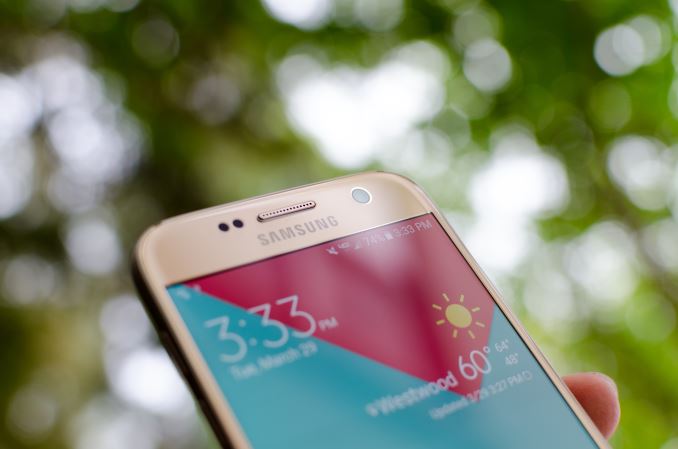
With part one of our Galaxy S7 review, it was clear that the Galaxy S7 was at least a mild improvement to the Galaxy S6 in some ways, but there were still many areas to investigate. At the time, we were in the middle of transitioning to our new 2016 benchmark suite, which meant that it was necessary to re-test the Galaxy S7.
Our 2016 benchmark suite attempts to really push our testing in general to a new level of depth and more importantly, more focused on the overall user experience. When reflecting upon the value of AnandTech from a testing perspective, it’s clear to me that while part of our value is running benchmarks across a wide range of phones, another part of our value is being able to run tests that others wouldn’t be able to run at all.
With our new test suite for 2016, our extended suite of benchmarks attempts to focus on the latter to go deeper in reviews in a meaningful way. I definitely enjoy examining architectural details through microbenchmarks, but for general reviews our standard test workflow needed to be focused on user experience in a deeper way. With this in mind, we can get into the data that we were missing with part 1 of the review. Of course, if you haven’t read part 1 of the Galaxy S7 review, I highly recommend reading it first just to get a better introduction into the basics of the Galaxy S7.
Battery Life
Of course, now that we have our full suite of benchmarks we can start to look over in detail how devices perform. While we’ve gone over some of the results before it’s probably fair to say that our discussion of battery life on the Galaxy S7 was woefully incomplete with part 1 of the review. It’s also worth noting that internally we were still working on our 2016 web browsing test at the time so it wasn’t necessarily complete and sufficiently consistent and accurate. In the time since, we’ve been able to get all of the bugs ironed out and get a test that provides useful data that our previous tests didn’t.
As battery life is a critical part of our testing, it’s important for us to get this right, and in order to get useful relative comparisons we have to make sure that every device is tested in the same manner to avoid bias in one way or another. In order to achieve this, all devices have all possible background services disabled, as well as sync and automatic app updates. In order to try and make an even comparison we also set the display to 200 nits brightness on a 100% average picture level display, also known as a blank white screen. However, one area that we aren’t necessarily able to control for 100% of the time is ambient temperature, device orientation, or material contact. While tests that don’t reach TDP limits won’t see any effects, TDP-limited tests will see a delta here, but it’s hard to estimate just how much of an impact exists here.
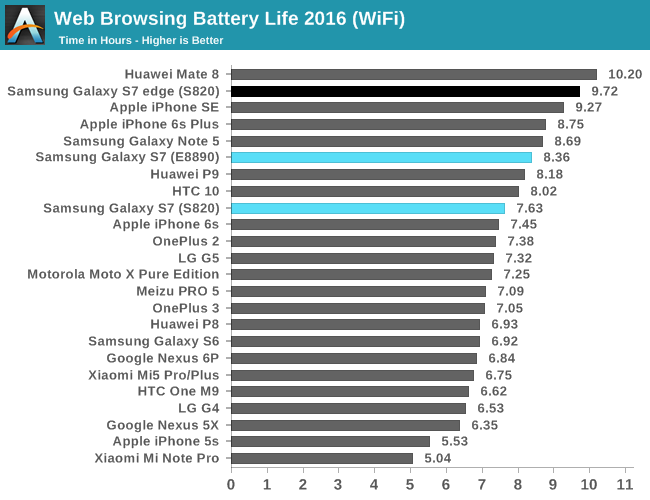
With this baseline in mind we can move on to the actual results. As seen in the chart above for WiFi web browsing on our new test it’s worth mentioning that the data here has changed as changes to the test have affected results, generally bringing battery life down or keeping it around the same. The Galaxy S7 does fairly respectably here, although the Snapdragon 820 version is definitely showing either architectural or implementation inefficiency here when compared to the Exynos 8890. A delta of about 10% means that the Exynos 8890 GS7 uses about 1.38W average here while the Snapdragon 820 GS7 uses about 1.51W in this test assuming that the battery capacity is nominal. If you subtract out an estimated display power the delta that can be attributed to non-display factors is something like 30% here. Interestingly, the HTC 10 is mildly more efficient here with its higher density LCD, with the AMOLED display consuming something like 10% more power despite the presence of dark-themed webpages to try and bring some balance here. The Galaxy S7 edge is pretty much the top here, but achieves its battery life through sheer battery size rather than efficiency.
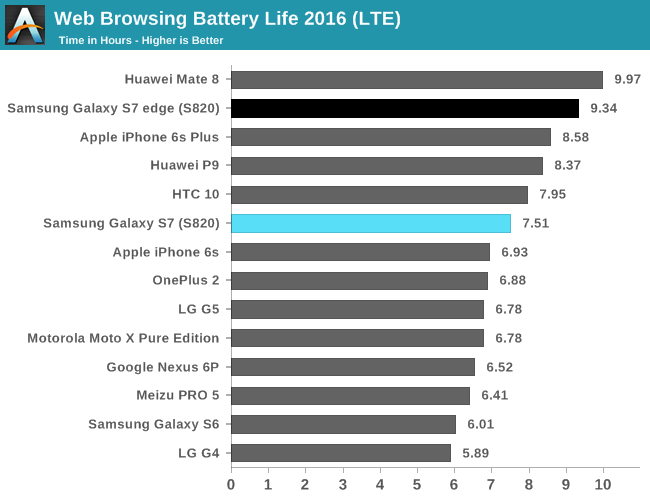
Moving on to LTE we can really start to see the battery life advantage that the Snapdragon 820 brings. It turns out that as a communications company, Qualcomm is good at making radios. One of the most obvious ways that this shows is in power, as the Snapdragon 820 basically has the same battery life whether you’re on LTE or WiFi, which isn’t necessarily the case with other devices. Unfortunately, we haven’t been able to test the Galaxy S7 with Exynos 8890 in comparable conditions for LTE so we can’t really see how power of the S820 modem compares with the Exynos’ Shannon modem, but we continue to see that the Galaxy S7 S820 is a bit behind the HTC 10 in battery life due to the use of an AMOLED display in high-APL workloads. However, the difference is nowhere near what it was in the past, and is close enough to not really make a huge difference. The Galaxy S7 edge performs well here, but on the basis of its battery size rather than efficiency.
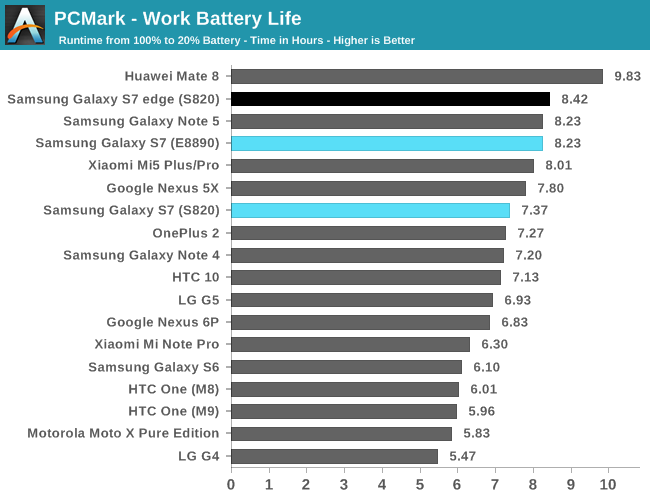
In the interest of not just relying on our own web browsing tests to try and get a handle for what battery life is like in general purpose compute situations, we continue to use PCMark’s battery life test to see how performance is in a benchmark that doesn’t attempt to equalize the amount of work done per unit time. Here the Galaxy S7 actually seems to be a fair bit better than the HTC 10, but this is likely due to the previously mentioned binning differences and some differences in governor as the delta in power and performance isn’t really all that much. The Galaxy S7 edge extends the lead here, again mostly due to the larger battery as the two devices are generally quite similar to each other.
Moving on to throttling performance we’ve transitioned to GFXBench’s Manhattan test on infinite rundown instead of T-Rex for this year as some devices from certain vendors have a tendency of reaching vsync on T-Rex which meant that it was difficult to see just how much throttling occurred over the duration of the test. After some testing it’s evident that for the most part throttling behavior is not necessarily changed by Manhattan either, so there’s not much need to retain T-Rex for high-TDP tests. Basemark OS II’s battery life testing is also rather questionable at this point, so we will no longer be reporting these scores as the methodology isn’t up to par with our expectations for 2016 and beyond.
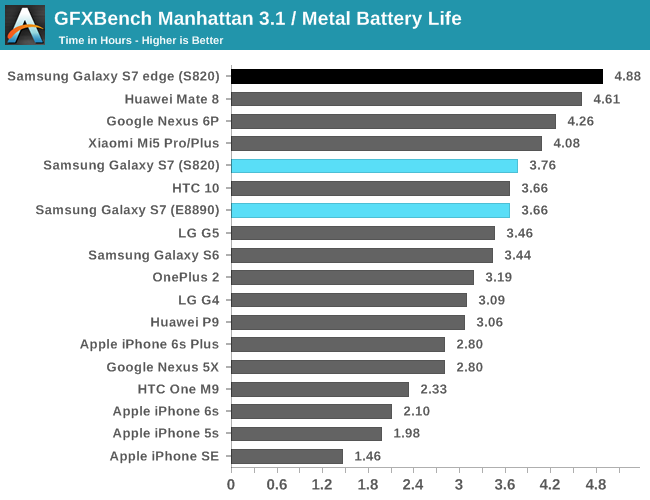

In the case of Manhattan, we continue to see some of the sinusoidal behavior seen in T-Rex throttling as it seems that Samsung’s throttling algorithms tend towards a more underdamped behavior than critically damped like HTC’s. However, for whatever reason it looks like the Galaxy S7 edge ends up with similar oscillating throttling behavior. Interestingly enough, even though the Galaxy S7 spends more time at higher performance states than the HTC 10, it manages to last longer, which is likely due to the lower APL of this content in conjunction with forced power save modes, and higher sustainable skin temperatures due to the glass back with heatpipe cooling to help distribute heat. Of course, the Galaxy S7 edge manages to last longer than either due to its larger size and battery.
Overall, the Galaxy S7 has decent battery life, while the S7 edge has great battery life due to its relatively large battery compared to its display size. The improvements here aren’t necessarily going to blow you away unless you get the Exynos 8890 variant, but it’s good to see that we’re finally back to improving on battery life with the launch of the Snapdragon 820 compared to the Snapdragon 810 and 808’s rather disappointing power efficiency due to the use of a high-power implementation and process node. I’m not sure the Snapdragon 820 is really the best design we’ve seen on 14LPP when it's more on par with 14LPE SoCs for efficiency, but it’s good enough that it doesn’t fundamentally compromise a device.


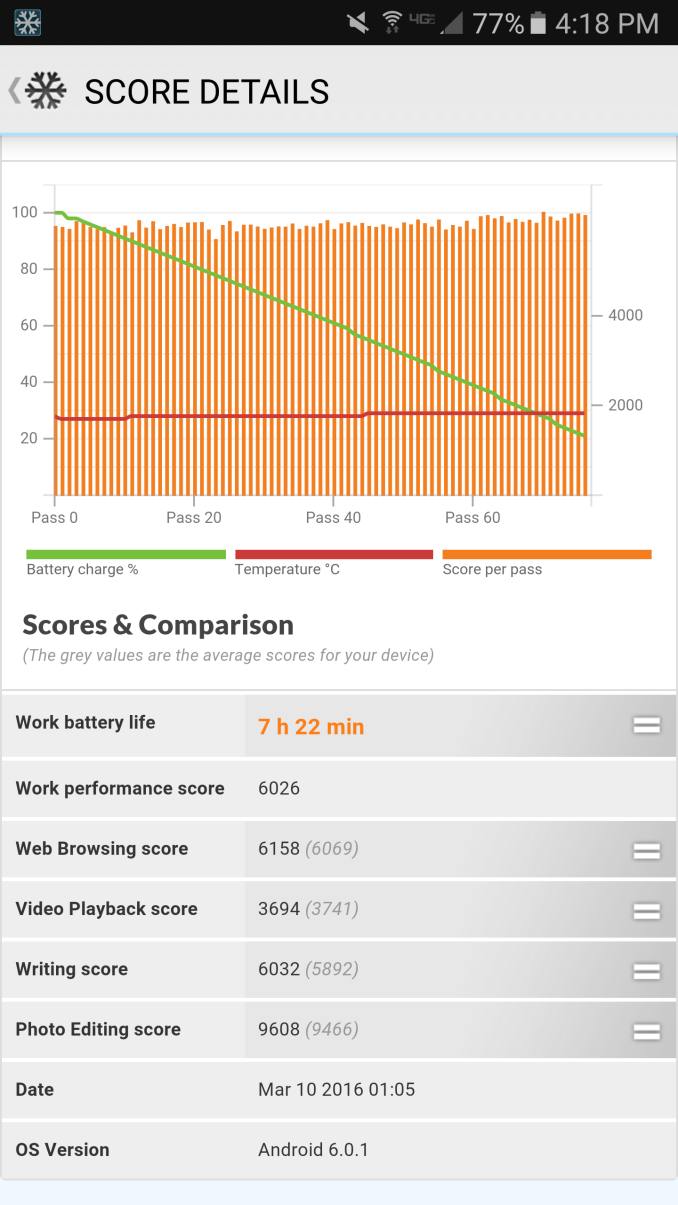
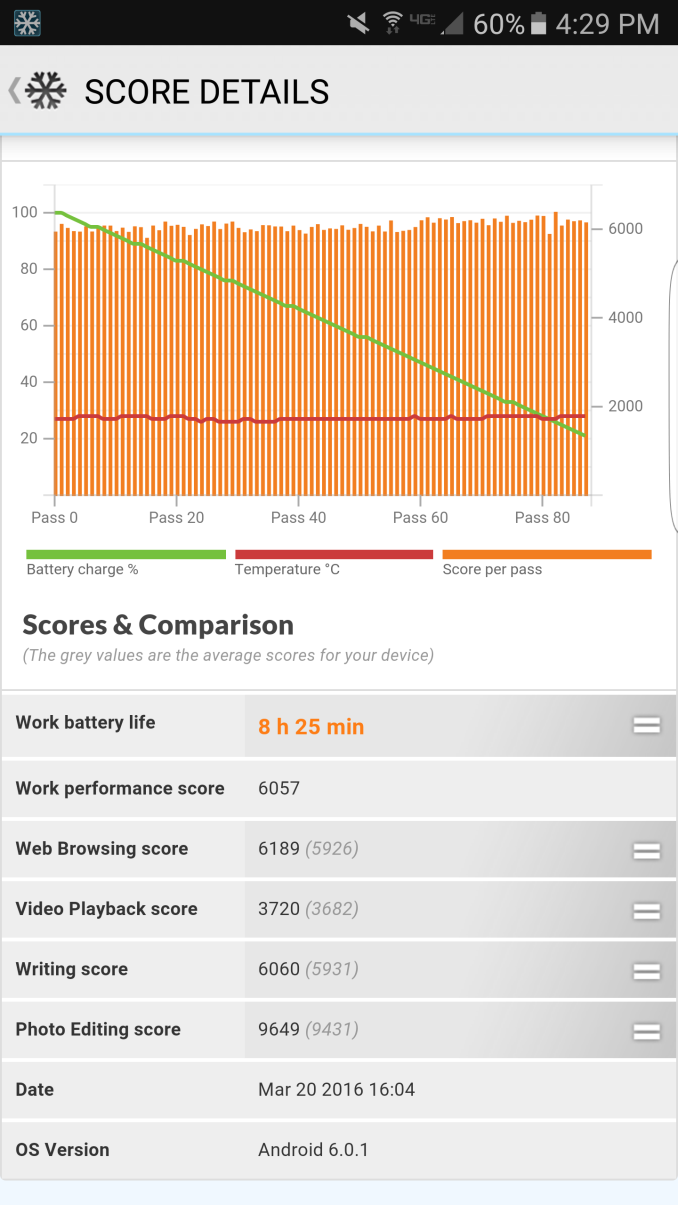
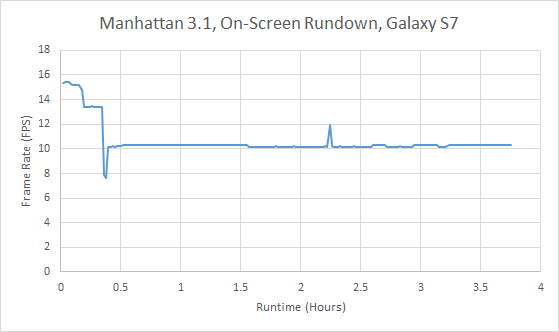
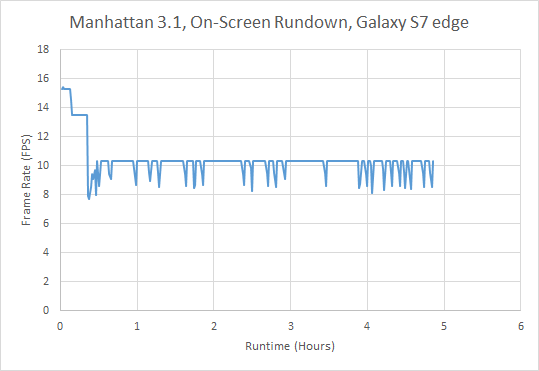








266 Comments
View All Comments
retrospooty - Wednesday, July 6, 2016 - link
Close... I wish Anandtech would get back to the "tech" part. It used to be about tech and now as you even agree, its about clicks and paying the bills.BurntMyBacon - Wednesday, July 6, 2016 - link
@dsumanik: "heres proof:http://www.ibtimes.com/apples-ios-still-getting-cr...
I kinda see what you're getting at here, but these numbers are from October of last year. Though, I couldn't help but note that according to these numbers, Windows is actually persisting in most markets. The numbers aren't great, but enough to be a significant presence. Even the U.S. is 3.5%. I thought we were seeing articles around this time period about how the Windows market share was sub-1%, insignificant, and dead to rights. Question is, are we sure these numbers are accurate? Or is it that tech review websites are preaching Windows doom and gloom to generate clicks? I suppose the second option would fit the mold that M2K is suggesting.
Byte - Tuesday, July 5, 2016 - link
Apple rules the mobile roost right now. Just look at the sales, app ecosystem, users. Why aren't you crying that Apple has all of that? Don't even get started at tablets, there isn't even any contest. One day though, maybe soon, it will come crashing down, just like what happened to Blackberry, what will you cry about then?Geranium - Wednesday, July 6, 2016 - link
Apple's CPU performs better running Apple optimized benchmark.jlabelle2 - Wednesday, July 6, 2016 - link
- There is something wrong with you if you think of people as with you and against you -I think it is pretty clear that the editorial line has changed since departure of Anand (...to Apple "cough").
For instance, when speaking of the camera, there is a mention that the resolution of the 12Mp S7 is not better than the 12Mp iPhone 6S (strange?) but when speaking of low light, as the iPhone is not anymore a contender (as the images show), then we mode the reference to LG or HTC. And this is constant all around Apple products review just to make the Apple shine when they should and when they are not, just move the discussion elsewhere.
I mean, qualifying the S7 design of average? Really?
- Look at the CPU performance and you see that the 820 and Exynos both struggle to hit the top of the charts. -
This is the ONLY area where iPhone are constantly shining. The iPhone 6 CPU was the best thing after slice bread here on this site: "the A8 SoC performs admirably ... It remains to be seen if other SoC manufacturers will catch up in their CPU architecture at one point or another, but for now Apple seems to be quite far in the lead in CPU performance".
But now that the S7 is having the same performance, you have: "the Galaxy S7 in its Snapdragon 820 variants performs pretty much as you'd expect with fairly respectable performance about on par with the iPhone 6 at least part of the time, which frankly still isn't enough ..." and "I have to install either a variant of Snapdragon Browser or Samsung's stock browser in order to get remotely acceptable performance".
So the performance is not enough and not remotely acceptable when it is not an iPhone?
And then come the GPU where it is very competitive and of course... the iPhone is nowhere to be seen.
Honestly, those kind of reviews are a reference for journalist school as the bias is becoming quite too much.
KoolAidMan1 - Saturday, July 9, 2016 - link
"There is something wrong with you"retrospooty and his brand obsessiveness in a nutshell
pablo906 - Friday, July 8, 2016 - link
Have you thought that maybe it's because Apple is doing amazing things with their hardware currently. They have the highest performing underlying storage of any phone by a wide margin, they have the fastest mobile SoC's out right now, and they have a very tidy app ecosystem with a very cohesive GUI that receives focused improvements in usability and performance. The other phone makers are measured in many categories against the bar that Apple sets. That's just a fact at this point. It's also impossible to discuss smart phones today without talking about iPhone vs. Android as that is literally the competition in the space today. iPhone vs Android.MonkeyPaw - Tuesday, July 5, 2016 - link
The iPhone 5s came out almost 3 years ago. I think we can move on.The Garden Variety - Tuesday, July 5, 2016 - link
Nope, some people apparently cannot. For retrospooty and a huge number of other regular visitors to Anandtech, ferreting out their bias boogeymen are an all-consuming passion. They honestly believe it's a "justice" issue—right and wrong, good and bad. It's instills the same feeling in them that religion or politics does in others.Maslow's Hierarchy of Needs at work.
retrospooty - Tuesday, July 5, 2016 - link
No, its not justice, its like i said in another comment below "That is OK, it's not like there aren't other Apple-centric sites out there and it is perfectly within the sites rights to run things the way they want to... But if you are looking for unbiased reviews on any products that compete with Apple, this site is no longer one of them, so browse accordingly." - It's just sad that this once well respected tech site is no longer trustworthy. I kid you not, Anandtech was my homepage, my first stop every time I launched my browser from 1998 to 2014. That is how often I was here. Now it is just another page in my feedly feed. Still pop in now and then to see whats up, and still sad to see the site has lost it's heart.